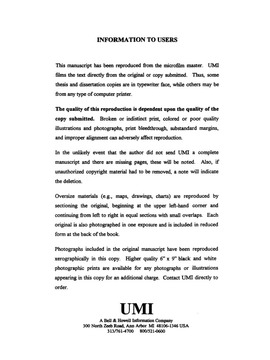| dc.contributor.author | Yeh, Jung-huel Becky. | en_US |
| dc.date.accessioned | 2013-08-16T12:30:27Z | |
| dc.date.available | 2013-08-16T12:30:27Z | |
| dc.date.issued | 1999 | en_US |
| dc.identifier.uri | https://hdl.handle.net/11244/5775 | |
| dc.description.abstract | The investigation of this speech community begins with an extensive description of the community and then analyzes the patterns of communication and interactions of the community through assessing various speech events and issues. Chapter IV provides an overview of the community, describing how members gather and talk in different venues. This chapter also portrays how members interact and communicate in the community by examining their ways of talking and gathering under the influence of both compulsory (institutional) and spontaneous (social) forces. Chapter V then examines how non- native speakers construct interactions in the presence of a native English instructor in the classroom. This chapter further demonstrates how instructor/student interactions initiate interactions among students and analyzes how non-native speakers develop turn-taking sensibilities and co-construct interactions. Finally, Chapter VI explains why participants become involved in seminar-type discussions in varying degrees, and analyzes and demonstrates the participation styles of less involved participants. | en_US |
| dc.description.abstract | This dissertation studies a speech community composed mostly of non-native speakers from different cultural and linguistic backgrounds in an English as a Second Language (ESL) institution. Through observing community members' gatherings and interactions in various speech events, the present study seeks to describe and examine the adjustments they make in communicative patterns and styles. Specifically, the goal of this project is to explore three issues in the "third tongue" speech community: ways of talking and gathering among non-native speakers, interaction order, and participation styles in the classroom. | en_US |
| dc.description.abstract | This project reviews and integrates inferencing theory (Gumperz, 1982, Gumperz & Cook-Gumperz, 1982a, 1982b) and research findings dealing with interactive features of both NS/NNS and NNS/NNS interactions, and then raises the question of what may be different about NNS/NNS interactions. The purpose of generalizing interactive features from previous NS/NNS and NNS/NNS investigations is threefold: (1) to describe features of intercultural interactions regardless of the native language of the interlocutors; (2) from these generalized features, to observe features specific to NNS/NNS interactions; (3) and to project the path of future NNS/NNS investigations. | en_US |
| dc.format.extent | vii, 134 leaves ; | en_US |
| dc.subject | English language Study and teaching Foreign speakers. | en_US |
| dc.subject | Speech Communication. | en_US |
| dc.subject | Education, Bilingual and Multicultural. | en_US |
| dc.subject | Intercultural communication. | en_US |
| dc.subject | Language, Linguistics. | en_US |
| dc.title | Intercultural interactions in multicultural contexts: "Third tongue" communications. | en_US |
| dc.type | Thesis | en_US |
| dc.thesis.degree | Ph.D. | en_US |
| dc.thesis.degreeDiscipline | Department of Communication | en_US |
| dc.note | Source: Dissertation Abstracts International, Volume: 60-01, Section: A, page: 0024. | en_US |
| ou.identifier | (UMI)AAI9918763 | en_US |
| ou.group | College of Arts and Sciences::Department of Communication | |
